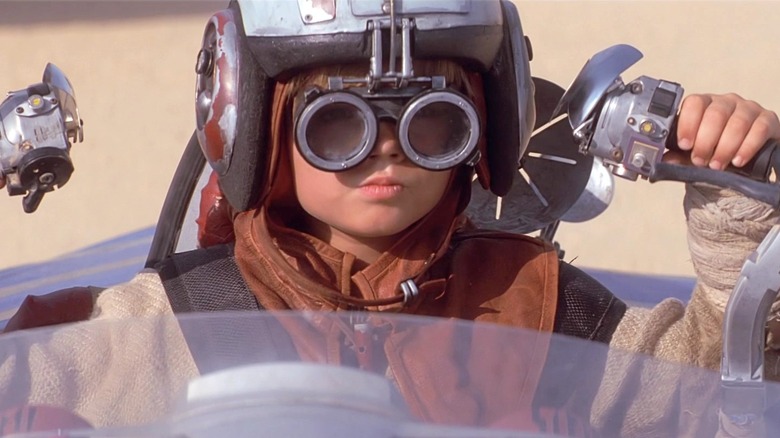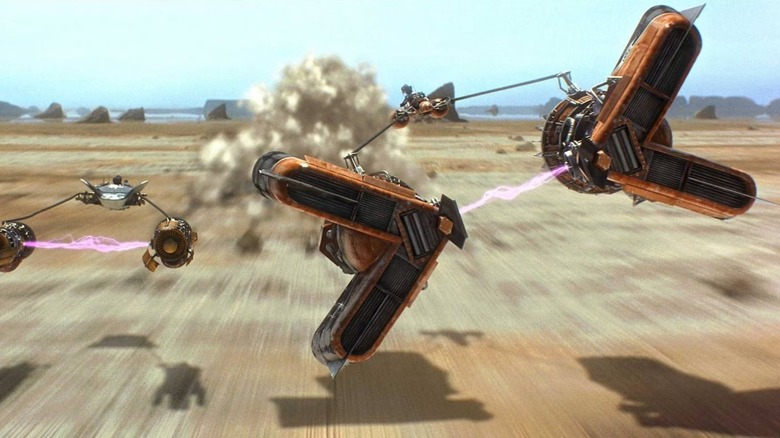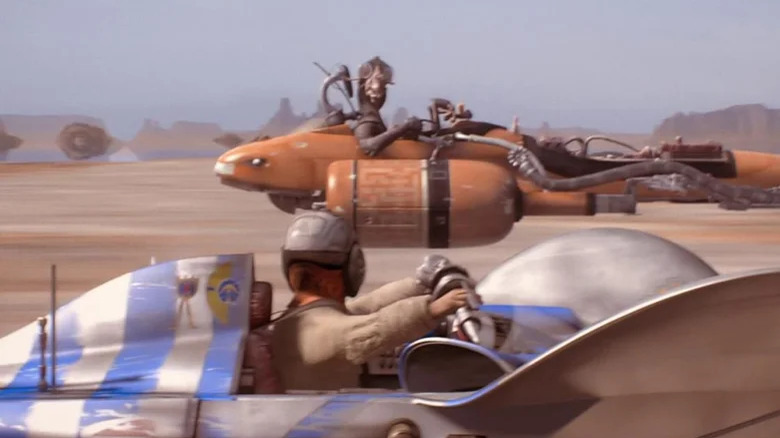Star Wars: The Phantom Menace's Podracing Scene Is Key To Understanding George Lucas
The "Star Wars" prequels constitute one of the biggest and most controversial set of movies of all time. Incredibly successful, both during its original theatrical run and in subsequent re-releases, "The Phantom Menace" was hugely anticipated by the summer of 1999, driving impossible-to-meet expectations. When the film was released, it made lots of money, but left some audiences cold. Over time, the image of "The Phantom Menace" as the beginning of the end for the franchise far, far away was cemented.
Except, that was 25 years ago. In the time since, kids who grew up on the prequels and additional material like "The Clone Wars" expanding the story and the characters have become more vocal online. It also helped that disappointment over the sequel trilogy has driven fans back to the prequels and George Lucas' unique and clear vision.
Rewatching "The Phantom Menace" during its 25th anniversary theatrical re-release, the movie's flaws are even more glaring, but its ambitions have also become easier to see on the big screen in the time since its original release. The film's politics, while poorly executed, are a brilliant idea — and there is no denying the undying power of Darth Maul. Most of all, however, I was struck by the podracing scene, which is not just one of the best "Star Wars" sequences and one of the best races ever put on screen, but also a very important scene when looking at George Lucas' whole career.
That's right. If you want to understand George Walton Lucas Jr., then you need to pay attention to the Boonta Eve Classic podrace.
Why The Phantom Menace's podracing scene remains great
It is easy to see why plenty of fans don't particularly like the podracing sequence. It is quite long, taking over 15 minutes of the 136-minute film, plus all the lead-up to the race in what essentially amounts to a giant detour from the main story. But the Boonta Eve Classic — an annual cultural event on Tatooine celebrating the anniversary of Boonta the Hutt's rise to godhood — is a thrilling sequence.
Looking at it as a race, the podracing scene offers what few live-action racing movies can: incredible destruction and mayhem. Given the arduous process of creating the podracing scene using digital effects, the wizards at ILM could deliver close-ups of pods blowing up, falling apart, and exploding, all without having to worry about stunt performers actually getting hurt. In the canon of the film, the Boonta Eve Classic is a dangerous track, with only 33% of racers finishing (and one being killed) the year Anakin Skywalker won. It's easy to see why, between the perilous terrain, the canyons, and the Tusken Raiders shooting at the racers — to say nothing of the acts of sabotage between competitors.
Watching the sequence on the big screen, the simply stunning sound design of the prequels combined with the gorgeous cinematography and the look of the pods reflected on the desert dunes makes for a thrilling Formula One sci-fi race. It's no wonder this scene inspired what remains one of the best "Star Wars" games ever.
Why podracing is so important to George Lucas' career
Before he was filmmaker who changed cinema forever, George Lucas was a racing aficionado. Growing up in Modesto, California, Lucas hoped to become a professional racecar driver — until he got involved in a near-fatal accident on the road. Though he switched careers to filmmaking, his love for speed and for racing were not lost, and you can see that passion in much of his cinematic work.
"American Graffiti," Lucas' sophomore feature, is where this is most explicit. The film is all about cruising culture and drag racing, but it is also reflective of George Lucas' cautions about his former hobby. In the film's climax, a drag race ends in disaster and it almost kills someone. Lucas is as careful about portraying the thrill, the excitement, and the freedom of racing as he is with the dangers of it. The film was a big hit, earning five Oscar nominations, and it cemented the arrival of a genius filmmaker.
But that was before "Star Wars," the only thing Lucas directed from 1977 until his retirement. He did produce many movies, but nothing racing-related after "American Graffiti," until the podracing scene. Rewatching the Boonta Eve Classic, there is a sense of sadness — almost like a desperate plea from a young Lucas trying to come out of his commercial shell, doing one last attempt at the kind of movie he was interested in making before "Star Wars." Francis Ford Coppola has said he felt sad upon seeing the success of that film, because it meant abandoning other projects. "George is truly a brilliant, talented person. Just look at 'American Graffiti' and see all the innovation," he said. "We should've had more."


